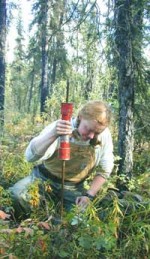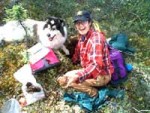Bonanza Creek LTER
Bonanza Creek LTER (BNZ) is located in boreal forest near Fairbanks, Alaska, and encompasses intensive study areas in forests along the floodplain of the Tanana River and in the uplands at the Caribou/Poker Creeks Research Watershed.
Research at BNZ focuses on how changes in climate and disturbance regime could potentially alter the functioning of Alaskan boreal forest. Graduate students are an integral part of the research program at BNZ, and contribute significantly to addressing these research goals. BNZ students benefit from research collaborations, sharing of site data, and the use of long-term datasets that are part of the LTER program.
Primary production in the boreal forest is strongly limited by nitrogen availability, and therefore understanding the role of nitrogen in the functioning of boreal forests cycle is critical when assessing how changes in climate or disturbance could affect the functioning of this system. Recent research shows that organic nitrogen can be directly utilized by plants, revising previous assumptions about the nitrogen cycle in these systems. Jack McFarland (supervisor: Roger Ruess) is using carbon and nitrogen isotope tracers to quantify the relative roles of inorganic and organic nitrogen in the nitrogen economy of angiosperm and gymnosperm-dominated forest communities. The composition and quantity of soil amino acids, a source of organic nitrogen, is being investigated across a floodplain successional sequence by Nan Werdin (supervisors: Knut Kielland and Rich Boone).
Across a similar chronosequence of sites, Rich Brenner (supervisor: Rich Boone) is looking at rates of nutrient cycling and seasonal and successional patterns of nutrient loss. Nitrogen-fixing alders provide the primary inputs of nitrogen into these floodplain and upland forests. Jennifer Mitchell (supervisor: Roger Ruess) is comparing rates of fixation across different site conditions and between species of alder that differ in other life-history characteristics. Fire disturbance is also an important control of nutrient cycling in boreal forests, and research by Susanne Trillhose (supervisor: Rich Boone) is documenting how burning of the organic soil alters net nitrogen mineralization rates in upland forests.
The nitrogen cycle is closely tied to the carbon cycle, and controls over carbon turnover can have important implications for forest productivity and carbon sequestration. In order to better understand how change in climate will affect the carbon cycle, Jason Vogel (supervisor: Dave Valentine) is using regional temperature gradients to examine temperature effects on root respiration, primary production, and decomposition. Sarah Masco (supervisor: Dave Valentine) is taking a closer look at the temperature sensitivity of microbial decomposition in burned black spruce forests and is evaluating how variations in soil carbon quality affect this relationship.
Change in climate will alter the fire regimes in the boreal forests, and the effects of fire are intricately tied to climate, vegetation dynamics, animal populations, and hydrological processes. Patterns of fire disturbance have important implications for the function interior Alaska boreal forests. Fire may influence the functioning of ecosystems at many levels. For example, research by Dorte Dissing (supervisor: Dave Verbyla) examines whether increased temperatures in large burn scars are sufficient to affect patterns of air convection and increase lightning activity around burned areas. Snowshoe hares that live within the northern boreal forest of North America experience an 8 to 10 year population cycle that varies in magnitude and these cycles could change under increased fire frequency and severity. Bjorn Flora (supervisors: Eric Rexsted and Knut Kielland) is studying the population dynamics of snowshoe hares. Jill Johnstone (supervisor: Terry Chapin) is studying how variations in soil biomass consumption by fire may influence the composition and density of tree seedlings that colonize a burn. Teresa Hollingsworth is studying the controls on landscape pattern of black spruce communities in interior Alaska in order to better understand the role of fire and climate in these systems.
Interior Alaska is an area of discontinuous permafrost, and the distribution of permafrost could change due to increased fire severity and frequency. Bob Bolton (supervisor: Larry Hinzman) is interested in how disturbances, such as wildfire, affect the hydrologic processes and moisture dynamics in areas of discontinuous permafrost. Kevin Petrone (supervisors: Rich Boone and Larry Hinzman) is examining the effect of fire disturbance and permafrost on the hydrologic transport of carbon and nutrients from terrestrial to aquatic boreal forest ecosystems
Graduate student research is essential for addressing important research questions proposed at the BNZ LTER site. Conversely, the LTER program at BNZ provides a framework for graduate students to explore interdisciplinary degrees and benefit from the expertise of investigators in multiple fields of research. In addition, students at BNZ LTER have the use of two long-term research sites, long-term datasets, as well as the opportunity for intersite comparisons. The availability of these resources, coupled with the energy and curiosity of our graduate students allows them to contribute significantly to answering the research questions central to the mission of the Bonanza Creek LTER site.

 Enlarge this image
Enlarge this image
